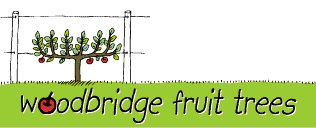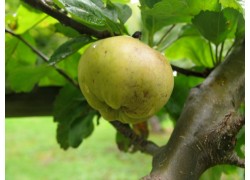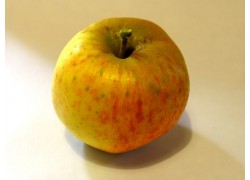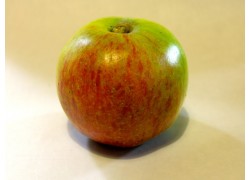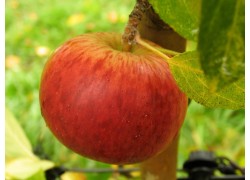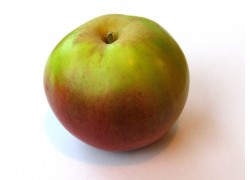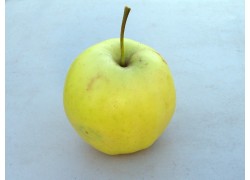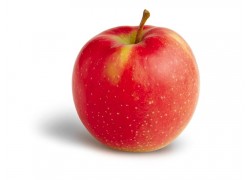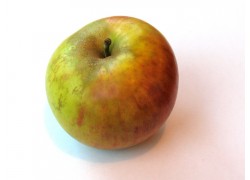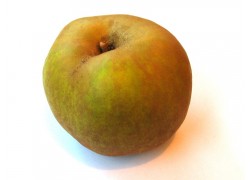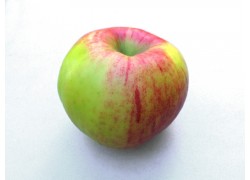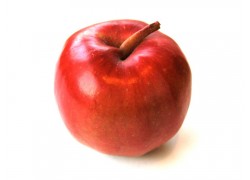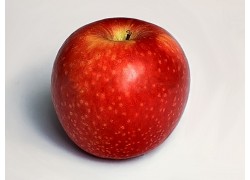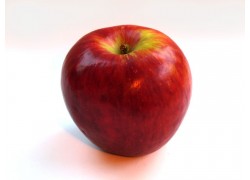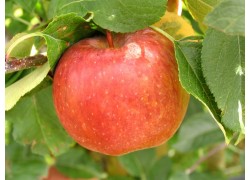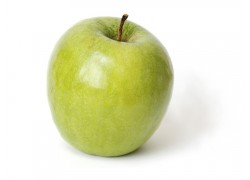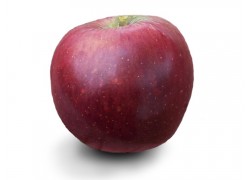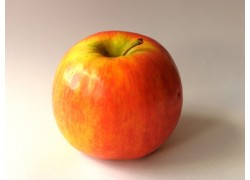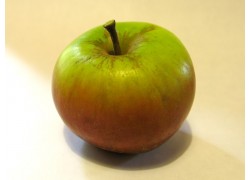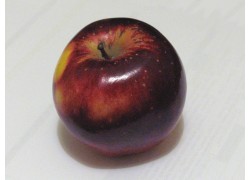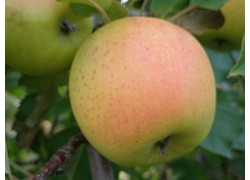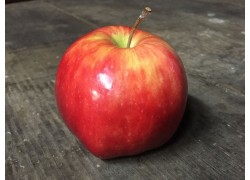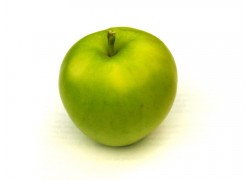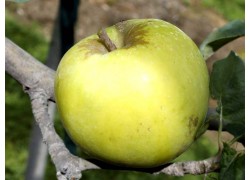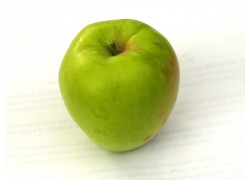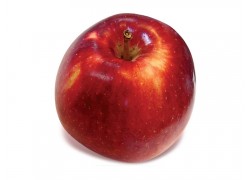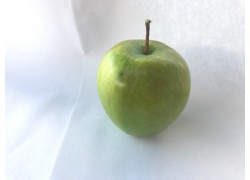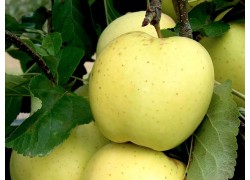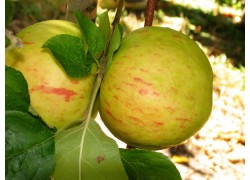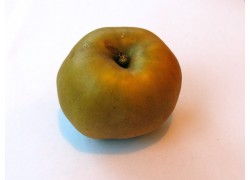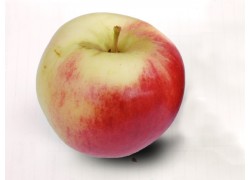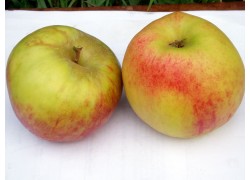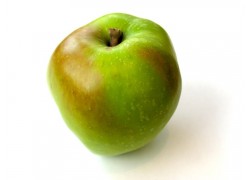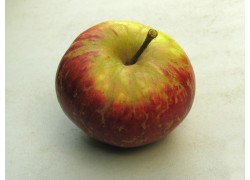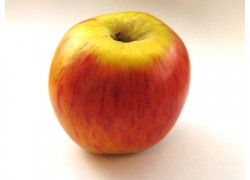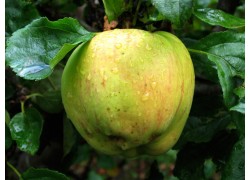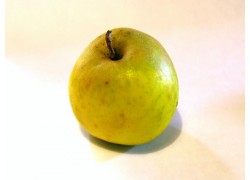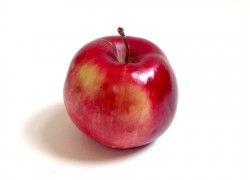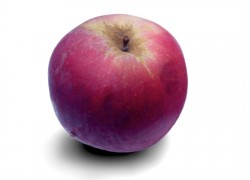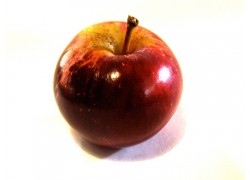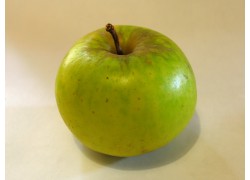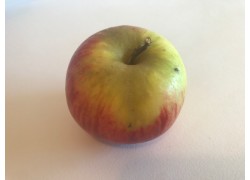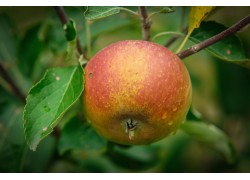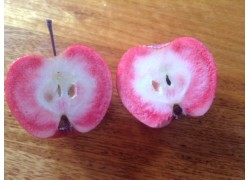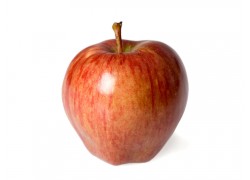No products
Filter
Heritage apple varieties on DWARF rootstock. These apples are ideal for back yards, small orchards, espaliers or anywhere where space is tight. Varieties ripen from Christmas to July providing 6 months of fruit. Wee included some more recent varieties as well as historic ones. There are excellent eating apples, cookers, big, small, common and un...
Heritage apple varieties on DWARF rootstock. These apples are ideal for back yards, small orchards, espaliers or anywhere where space is tight. Varieties ripen from Christmas to July providing 6 months of fruit. Wee included some more recent varieties as well as historic ones. There are excellent eating apples, cookers, big, small, common and unusual. Something for every occasion.
Dwarf Apples There are 95 products.
-
Calville Blanc D'Hiver Dwarfing Ripens: May - June
Prized in the kitchen - famous for making delicious 'tartes aux pommes' as it holds its shape when cooked. Under an irregular yellowish russeted skin, it has an appealing aromatic flesh that is wonderful eaten fresh and excellent for making cider. A true historic apple dating back to the 1600's in Normandy, France.
$39.50 -
Cornish Aromatic Dwarfing Ripens: May - June
A handsome old English apple from Cornwall discovered in 1813. High quality eating apple, quite squat in shape with yellow flushed, red skin with occasional russet patches. The flesh is firm, yellow and when caught at its peak of ripeness has a wonderfully aromatic flavour with a hint of anise. Ripens here in early May.
$39.50 -
Court Pendu Plat Dwarfing Ripens: May - June
This is considered the oldest apple known, introduced into Europe in Roman times. Small in size, yellow skin flushed with orange and red, sometimes russet. Brisk acid flavour when first picked, mellowing to sweet and fully flavoured as it matures. Flowers late (avoids frost) and just superb considering it's about 1500 years old!
$39.50 -
Crofton Red Dwarfing Ripens: May - June
An attractive small apple with skin red and orange stripes over a green background. The flesh is white, with good crunch, and stores very well. Good size for a lunchbox. Developed by Joseph Cato in the Hobart / Cygnet area in the 1830's
$39.50 -
Ida Red Dwarfing Ripens: May - June
A very handsome late ripening, deep red apple - a cross between Jonathan and Wagener from Idaho USA in 1942. Crisp flesh and an uncomplicated sweet / acid tasting flesh. Great cooked as well as eaten fresh and stores exceptionally well.
$39.50 -
Jim Reilly Dwarfing Ripens: May - June
It looks like one of it's parents is Golden Delicious (as are Pink Lady, Freyberg, Gala and Jonagold). It is a large, handsome apple with green to gold skin with more zing than a Golden, making it an outstanding eating apple. We can't track down who Jim Reilly is but we think he's done pretty well.
$39.50 -
Jonagold Dwarfing Ripens: May - June
A cross between Golden Delicious and Jonathan, Jonagold grows medium to large red fruit of intense flavour. The creamy yellow flesh is light, terrifically crunchy and memorably juicy. Solid Red skin with some yellow tones, and maybe a little stripe. Creamy The flavour has the tantalising taste of both parents. Ripens quite late and excellent keeper. If...
$39.50 -
Prinzenapfel Dwarfing Ripens: May - June
Literally translates 'Apple of the Prince' but known by many other Germanic names, widely grown in Europe. It has a characteristic long shape, orange/red in colour with rich dense aromatic flesh. Keeps well.
$39.50 -
Reinette Dorée Dwarfing Ripens: March - April
Also called Golden Reinette, one of Europe's most famous old apples, as far back as the 1600's. It ripens fairly late, has a russeted skin and dense aromatic flesh. Used for both eating and cooking, Reinette dorée was typically one of those apples cellared to be used from Christmas onward through an European winter.
$39.50 -
Rome Beauty Dwarfing Ripens: May - June
Rome produces large brilliant glossy red fruit that resists bruising and is a heavy cropper. Good eating and becomes very sweet the riper it gets. Originating on the northern bank of the Ohio River in a town called Rome in the early 1800's where it appeared from a sucker below the graft of an orchard tree. Was grown commercially for some time in the USA and
$39.50 -
Splendour Dwarfing Ripens: May - June
Large and blocky in shape and orange-red to dark red in colour it has yellowish white very crisp flesh, sweet yet subacid. Like Freyberg and Braeburn, another excellent NZ apple. Ripens late but hangs and stores well.
$39.50 -
Sundowner Dwarfing Ripens: May - June
Large red fruit striped with yellow and juicy, sweet flesh. Originating in Western Australia, 1973 by John Cripps, this is a cross between a Golden Delicious and Lady Williams. That makes it the sister to Pink Lady. A very palatable and successful Australian apple. Suitable for low-chill climates.
$39.50 -
Democrat Black Dwarfing Ripens: June - July
The Dark Red (black) form of Democrat. For a long time Tasmania's mainstay export apple up until the 1980's, of a cannonball consistency and excellent keeping qualities. When left to fully ripen on the tree they are a great eating apple. Brilliant red skin and a crunchy flesh. Quite a sight when all the leaves have fallen and the red orbs are still...
$39.50 -
Fuji Dwarfing Ripens: June - July
A well known variety developed in Japan from it's parent Red Delicious. An attractive red skin, crisp yellowish flesh, uncomplicated deep sweet flavour and is always predictably juicy. Medium to large sized fruit. Fuji stores well - improving in quality and flavour. A thoroughly modern apple, and one of the latest maturing varieties. Suitable for...
$39.50 -
Granny Smith Dwarfing Ripens: June - July
This famous apple originated as a chance seedling in the back garden of a Mrs. Mary Anne Smith of Ryde near Sydney around 1860. It's thought to be the offspring of a variety called 'French Crab' which it closely resembles. Granny's are large and very green with prominent dots on the skin. The white flesh is very crisp, juicy and acid. Unfortunately the...
$39.50 -
Lady Williams Dwarfing Ripens: June - July
This is a true Australian Federation apple believed to be the daughter of Rokewood and Granny Smith both of which are famous old Australian varieties. It is a large apple, maturing July or even later and keeps extremely well. Brilliant red purple skin, longish conical fruit with excellent flavour. Tree very vigorous and upright. This variety originated in...
$39.50 -
Pink Lady Dwarfing Ripens: June - July
Most people will know Pink Lady because of it's popularity Australia wide. It's has fairly large fruit with excellent appearance, pink to pale red blush over a yellow background. Nicely flavoured pale yellow firm flesh. Matures very late and stores very well. Presently Australia's most famous apple: 3rd generation Australian, starting from Rokewood -->...
$39.50 -
Sturmer Dwarfing Ripens: June - July
Feedback from our customers rates Sturmer as one of the most satisfying apples to grow. It's extremely late, very acid, and is really a great all rounder - eaten fresh, cooked, juiced or made into cider. By modern standards it's no beauty; with orange/yellow russeted skin, a dense yellowish flesh, and medium in size. It's a very heavy cropper and stores...
$39.50 -
Duke Of Clarence Dwarfing Ripens: June - July
Once widely grown apple in the Tasmanian apple industry in the 1950's but there is little mention of this variety in the literature. An dark burgundy skin over green when ripe, these medium sized beauties polish to a high gloss. Pale to cream flesh, has an outstanding sweet flavour. So good that we thought it worth re-introducing this apple again.
$39.50 -
Mutsu Dwarfing Ripens: May - June
Fruit tend to be green all over, medium to large in size and very heavy regular cropping. Mutsu originated in Japan in the 1940's, an offspring of Golden Delicious. The flesh is crunch and extremely juicy with a sprightly (some say fruit salad) flavour that's unique. An apple that seems to satisfy all tastes, as we're always getting good feedback about it...
$39.50 -
Ruby Neige Dwarfing Ripens: June - July
A stunning looking glowing red apple, round in shape, with very white flesh. Late ripening, amazing crunch and very good flavour. Low acid.
$39.50 -
Early Victoria Dwarfing Ripens: January
The earliest ripening cooking apple that we know of. Very prolific tree, laden with small bright green codling fruit. Eaten fresh, it's flesh is quite soft and the sweet acid makes your tongue tingle. From England around 1900. Cooks to a subacid fluffy consistency needing minimal sugar added.
$39.50 -
Lodi Dwarfing Ripens: January
Lodi is one of the early apples, a medium sized apple light green to greeny-yellow when ripe. Like all early apples, they just dont keep, but their sprightly flavour signifies the beginning of the apple season, and make them worth growing. Thought to be an offspring of white transparent (and Montgomery), and has probably superior in both flavour and shelf...
$39.50 -
Sugarloaf Pippin Dwarfing Ripens: January
A long narrow shaped pale yellow apple with white on the sunny side. Crisp, with high acid content making it quite zingy eaten fresh and excellent cooked. A seedling from a white transparent and like it's parent doesn't keep long. Interestingly, it died out in England, and we have sent propagating material back to the UK.
$39.50 -
Empire Dwarfing Ripens: March
Empire is a cross between Mcintosh and Red Delicious, a result of an extensive breeding program in Geneva, New York in 1945. It's a medium to large apple, very red and regular in shape, almost perfectly round. It has an uncomplicated flavour, sweet cruncy slightly creamy flesh. Interestingly, it's sibling "Spartan" which has the same parentage is quite...
$39.50 -
Goldsmith Dwarfing Ripens: June - July
Goldsmith is a cross between Granny Smith and Golden Delicious. Completely green in colour, the shape is destincly less round than a Granny and more that of a golden delicious. The flavour is also a remarkable mix of the two - one can appreciate the acid of the Granny, but the sweet of the Golden.
$39.50 -
Greensleeves Dwarfing Ripens: February - March
This apple is a cross between James Greives and Golden Delicious, developed in 1966 in Kent, UK. Sweet, juicy and crisp, with a warm yet slighly sharp taste make it a very good eating apple.Inherited from the Golden Delicious is the golden yellow skin with little russet spots, but a slightly squatter in shape.
$39.50 -
Twenty Ouncer Dwarfing Ripens: February - March
This is one of the largest varieties we grow. Just huge, rivaling Belle Cacheuse and Peasgood Nonesuch in size. And as the name suggests, the fruit are up to twenty ounces (566g) in weight! Greenish in colour flushed and striped where the sun gets it. Coarse but tender yellowish flesh, cooks fantastically and is good eaten too - shared between 4 people!...
$39.50 -
Fenouillet Gris Dwarfing Ripens: March - April
This is the most unusual apple we grow - it's as far from the supermarket stereotype as you can get. Originating in France as far back in the 1600's, a small reddish orange blocky apple almost totally russetted. The flesh is deep yellow and has a distinctly delicious anise flavour. No apple collection is complete without this one.
$39.50 -
Australian Beauty Dwarfing Ripens: April - May
An attractive Australian apple, greenish-white skin with red on the sunny side. Flavour similar to Granny Smith, with dense crisp flesh. Tends to hang for a long time on the tree. Thought to be a seedling of Granny Smith. Rated highly at our recent apple tasting.
$39.50 -
Baldwin Dwarfing Ripens: April - May
A large handsome red apple with yellow flesh – crisp, crunchy, juicy with a hint of spice. Originating as a seedling from Massachusetts around 1750’s, it rose temporarily to commercial success in the early 1900’s in the USA. This apple always attracts keen interest at our apple tastings.
$39.50 -
Catshead Dwarfing Ripens: April - May
This is a majestic apple - large dense dark green apple with flattish sides. Often a little red develops on the sunny side. White flesh. Known in England as far back as the 1600's. Good eaten fresh but comes into itself as a cooker (a costard) that develops a wonderful spicy flavoured pulp.
$39.50 -
Kidd's Orange Red Dwarfing Ripens: March - April
An excellent eating apple, no surprise due to it's parentage: Cox's Orange and Red Delicious, developed in New Zealand by John Kidd in 1924. The skin is a flushed orange red with a slight russet while the flesh is aromatic, crisp, sweet and creamy white. Always rates very high in apple tasting events. It stores well.
$39.50 -
Lord Lambourne Dwarfing Ripens: March - April
A cross between James Grieve and Worcester Pearmain. Often used to be marketed as Cox's Orange Pippin and is of comparable high quality, but a much easier apple to grow and one of the few apples considered to be self pollinating. Orange flush over green skin, with a hint of russet. Flesh creamy white, juicy and well flavoured. Matures late March just...
$39.50 -
Peasgood's Nonsuch Dwarfing Ripens: March - April
A huge apple of almost grapefruit size. The flesh abundant, very sweet, cooks well and is great for eating. Definitely share it with someone! In our apple tastings, Peasgood's Nonsuch is always met with disbelief. We love its name.
$39.50 -
Pine Golden Pippin Dwarfing Ripens: March - April
Our favourite russet. The fruit are small, with a golden skin, and crisp yellow flesh with perhaps a shade of green. Hiding beneath this gnarled exterior lies a flesh of rich aromatic flavour having a hint of pineapple. Peter Cundall's favourite apple. Originating from England around 1860.
$39.50 -
Pomme De Neige Dwarfing Ripens: March - April
Also known as Snow apple, Lady in the Snow, Fameuse, Chimney Apple and about 20 other names which reflects its popularity and how widely distributed this variety is. Originated around 1730 in Quebec, Canada an offspring of McIntosh. The attractive smallish fruit have red sometimes striped skin on a background of pale red and green. The flesh is very white
$39.50 -
Red Cleopatra Dwarfing Ripens: March - April
This attractive medium sized red apple has consistently delighted by those who try them at our apple tastings. Extremely crunchy, with flesh that almost splits when bitten. A fresh sweetf lavour. Red Cleo is little known in the literature. We had thought that is was a red form of New York Pippin: a yellow/green apple once grown commercially but we have...
$39.50 -
Spartan Dwarfing Ripens: March - April
A striking beautiful apple, with purplish black skin and whiter-than-white flesh, looking stunning when polished. Better still, the flesh is crisp, quite juicy and excellent eaten straight off the tree. Originating in Canada in the 1920's, it's a cross between McIntosh and Newtown Pippin. Definitely a favourite.
$39.50 -
Freyberg Dwarfing Ripens: April
An amazing apple, drawing qualities from both it's parents - Golden Delicious and Cox's Orange Pippin. So it's easy to see why is so widely enjoyed. Medium sized fruit, the skin a lovely greenish yellow and has the tiny russet fleck similar to a Golden. It ripens midseason and hangs well on the tree.
$39.50 -
Elstar Dwarfing Ripens: March
A very attractive almost perfectly round apple, mostly red, with an occasional stripe but a destinctive collar of russeted yellow around the stem. Very good eating apple with good flavour and crunch. Originated in the Netherlands, in the town of Elst in the 1950's. It's a Golden Delicious crossed with on otherwise hardly known apple called Ingrid Marie.
$39.50 -
Rattling Cox's Orange Pippin Dwarfing Ripens: February - March
This must be the world's most revered apple, originating in Buckinghamshire England in 1825, thought to be an offspring of Ribston Pippin. There are many different cultivars of this apple, and this one is one of the oldest - very tasty but smaller fruit with russeted yellow/orange skin. Crisp juicy flesh when ripe, with a richness that is difficult to...
$39.50 -
Magnus Summer Surprise Dwarfing Ripens: February - March
The fruit are quite attractive - bright red and medium in size, but that is the red flesh and white core are quite remarkable when bitten into. The flavour is sweet and the tree crops heavily. Like its parent, the Huonville Crab, it has purple/ green leaves and stem. Quite remarkable. This apple is the result of my fathers' efforts into apple breeding....
$39.50 -
Red Delicious (Hi Early) Dwarfing Ripens: March
A very famous apple - a classic red apple with a distinctive shape. Red, with a yellow stripe, with a mild sweet flavour, and firm flesh. Discovered as a chance seedling in Iowa 1880 where it was called Hawkeye, and later sold to Starks Brothers who renamed it Delicious. It has enjoyed huge success as a commercial apple, up to as recently as 10-20 years...
$39.50 -
Democrat Dwarfing Ripens: June - July
The red form of Democrat. For a long time Tasmania's mainstay export apple up until the 1980's, of a cannonball consistency and excellent keeping qualities. When left to fully ripen on the tree they are a great eating apple. Brilliant red skin and a crunchy flesh. Quite a sight when all the leaves have fallen and the red orbs are still hanging. It's...
$39.50
